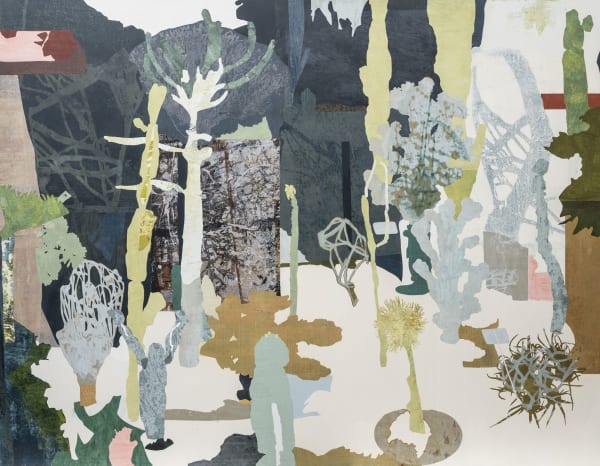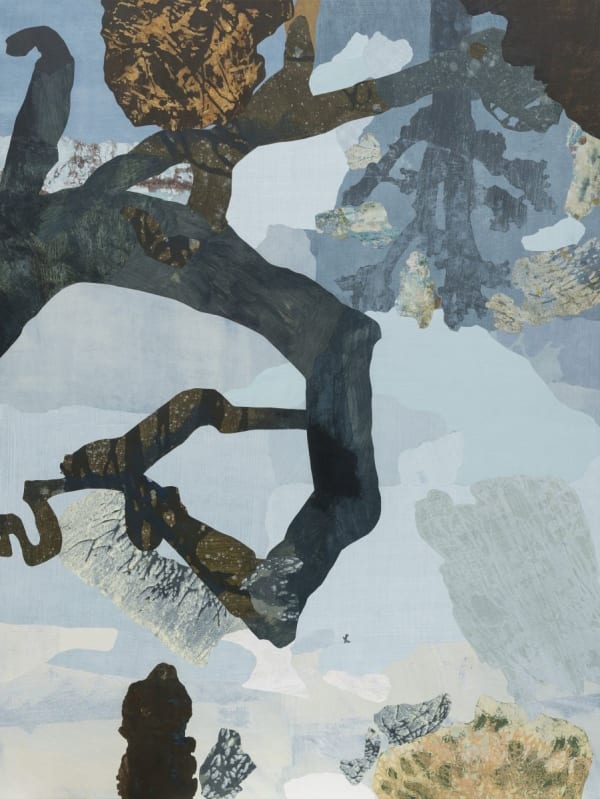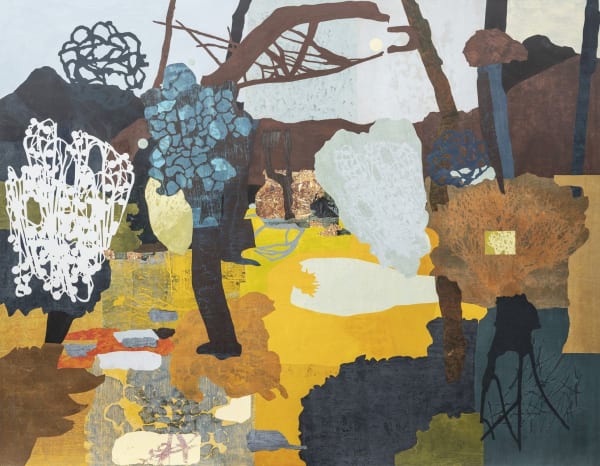Nicola Moss: Plants Give Me Hope
-
 Nicola MossAs If Nature Loved Variety For Its Own Sake, 2021acrylic & paper collage on linen140 x 180 cm, 143 x 183 cm (framed)
Nicola MossAs If Nature Loved Variety For Its Own Sake, 2021acrylic & paper collage on linen140 x 180 cm, 143 x 183 cm (framed) -
 Nicola MossAvian Home, 2021acrylic & paper collage on linen92 x 122 cm, 95 x 125 cm (framed)
Nicola MossAvian Home, 2021acrylic & paper collage on linen92 x 122 cm, 95 x 125 cm (framed) -
 Nicola MossBelieve, 2021acrylic & paper collage on linen41 x 41 cm, 44 x 44 cm (framed)
Nicola MossBelieve, 2021acrylic & paper collage on linen41 x 41 cm, 44 x 44 cm (framed) -
 Nicola MossBelieve II, 2021acrylic & paper collage on linen41 x 41 cm, 44 x 44 cm (framed)
Nicola MossBelieve II, 2021acrylic & paper collage on linen41 x 41 cm, 44 x 44 cm (framed) -
 Nicola MossBreathe in, 2021acrylic & paper collage on linen112 x 92 cm, 125 x 95 cm (framed)
Nicola MossBreathe in, 2021acrylic & paper collage on linen112 x 92 cm, 125 x 95 cm (framed) -
 Nicola MossFrom the Moment We Met, 2021acrylic, graphite & paper collage on linen112 x 224 cm, 115 x 227 cm (framed)
Nicola MossFrom the Moment We Met, 2021acrylic, graphite & paper collage on linen112 x 224 cm, 115 x 227 cm (framed) -
 Nicola MossGrounded in Silverbeet Red, Sky Blue, 2021acrylic & paper collage on linen140 x 180 cm, 143 x 183 cm (framed)
Nicola MossGrounded in Silverbeet Red, Sky Blue, 2021acrylic & paper collage on linen140 x 180 cm, 143 x 183 cm (framed) -
 Nicola MossHouse Plant, 2021acrylic & paper collage on linen41 x 41 cm, 44 x 44 cm (framed)
Nicola MossHouse Plant, 2021acrylic & paper collage on linen41 x 41 cm, 44 x 44 cm (framed) -
 Nicola MossHouse Plant II, 2021acrylic & paper collage on linen41 x 41 cm, 44 x 44 cm (framed)
Nicola MossHouse Plant II, 2021acrylic & paper collage on linen41 x 41 cm, 44 x 44 cm (framed) -
 Nicola Mossin a Land of Eternity Trees, 2021acrylic & paper collage on linen152 x 152 cm, 155 x 155 cm (framed)
Nicola Mossin a Land of Eternity Trees, 2021acrylic & paper collage on linen152 x 152 cm, 155 x 155 cm (framed) -
 Nicola MossIt Began With a Seed, 2021acrylic & paper collage on linen92 x 92 cm, 95 x 95 cm (framed)
Nicola MossIt Began With a Seed, 2021acrylic & paper collage on linen92 x 92 cm, 95 x 95 cm (framed) -
 Nicola MossLife on the Verge, 2021acrylic & paper collage on linen112 x 198 cm, 115 x 201 cm (framed)
Nicola MossLife on the Verge, 2021acrylic & paper collage on linen112 x 198 cm, 115 x 201 cm (framed) -
 Nicola MossOn a Floating Sea, 2021acrylic & paper collage on linen112 x 152 cm, 115 x 155 cm (framed)
Nicola MossOn a Floating Sea, 2021acrylic & paper collage on linen112 x 152 cm, 115 x 155 cm (framed) -
 Nicola MossOne Seed at a Time, 2021acrylic, mixed media & paper collage on linen152 x 152 cm, 155 x 155 cm (framed)
Nicola MossOne Seed at a Time, 2021acrylic, mixed media & paper collage on linen152 x 152 cm, 155 x 155 cm (framed) -
 Nicola MossOut Back, 2021acrylic & paper collage on linen60 x 60 cm, 63 x 63 cm (framed)
Nicola MossOut Back, 2021acrylic & paper collage on linen60 x 60 cm, 63 x 63 cm (framed) -
 Nicola MossPlant Dreams II (Travel Companion), 2021acrylic & paper collage on linen60 x 60 cm, 63 x 63 cm (framed)
Nicola MossPlant Dreams II (Travel Companion), 2021acrylic & paper collage on linen60 x 60 cm, 63 x 63 cm (framed) -
 Nicola MossPlant Dreams III (Party), 2021acrylic & paper collage on linen41 x 41 cm, 44 x 44 cm (framed)
Nicola MossPlant Dreams III (Party), 2021acrylic & paper collage on linen41 x 41 cm, 44 x 44 cm (framed) -
 Nicola MossSafe/Gathering, 2021acrylic & paper collage on linen92 x 92 cm, 95 x 95 cm (framed)
Nicola MossSafe/Gathering, 2021acrylic & paper collage on linen92 x 92 cm, 95 x 95 cm (framed) -
 Nicola MossSheltered III, 2021acrylic & paper collage on linen112 x 92 cm, 125 x 95 cm (framed)
Nicola MossSheltered III, 2021acrylic & paper collage on linen112 x 92 cm, 125 x 95 cm (framed) -
 Nicola MossSpring Hopes Eternal, 2021acrylic & paper collage on linen140 x 180 cm, 143 x 183 cm (framed)
Nicola MossSpring Hopes Eternal, 2021acrylic & paper collage on linen140 x 180 cm, 143 x 183 cm (framed) -
 Nicola MossThe Beginning of a Flower Forest, 2021acrylic, charcoal frottage & paper collage on linen112 x 152 cm, 115 x 155 cm (framed)
Nicola MossThe Beginning of a Flower Forest, 2021acrylic, charcoal frottage & paper collage on linen112 x 152 cm, 115 x 155 cm (framed) -
 Nicola MossThe Chosen, 2021acrylic & paper collage on linen112 x 112 cm, 115 x 115 cm (framed)
Nicola MossThe Chosen, 2021acrylic & paper collage on linen112 x 112 cm, 115 x 115 cm (framed) -
 Nicola MossThe Green Commons Community, 2021acrylic, oil pastel & paper collage on linen152 x 152 cm, 155 x 155 cm (framed)
Nicola MossThe Green Commons Community, 2021acrylic, oil pastel & paper collage on linen152 x 152 cm, 155 x 155 cm (framed) -
 Nicola MossTranquil (the Gift), 2021acrylic & paper collage on linen152 x 224 cm, 155 x 227 cm (framed)
Nicola MossTranquil (the Gift), 2021acrylic & paper collage on linen152 x 224 cm, 155 x 227 cm (framed) -
 Nicola MossTrees are the Answer, 2021acrylic, graphite & paper collage on linen112 x 198 cm, 115 x 201 cm (framed)
Nicola MossTrees are the Answer, 2021acrylic, graphite & paper collage on linen112 x 198 cm, 115 x 201 cm (framed) -
 Nicola MossUrban Grotto, 2021acrylic & paper collage on linen152 x 152 cm, 155 x 155 cm (framed)
Nicola MossUrban Grotto, 2021acrylic & paper collage on linen152 x 152 cm, 155 x 155 cm (framed)
Always at the heart of Nicola Moss’ art is an honest engagement with environmental awareness, orbiting the ever-relevant question: What is sustainability? Her thoughtfully articulated paintings and paper collages circulate increasing tensions between ‘Nature’ and ‘Culture’ while, at the same time, optimistically positing harmony and symbiosis as a possible pathway for the future. In this way, the works visualise what Michiel Schwarz and Joost Elffers term ‘sustainism’ – a cultural era shaped by a new collective consciousness in which the world is more connected, more localised and more sustainable.
While her practice largely pivots on broader ideas of political, historical and philosophical significance, Moss’ new series ‘Plants give me hope’ responds to more localised, personal feelings of wellbeing encountered when in contact with plants. ‘Each work in this exhibition reflects on how a garden or greenspace has made me feel’, Moss explains. At a time of travel restrictions, she harnessed inspiration from the ‘humble plant spaces’ around her; community food gardens, parks, nurseries, gardens of national significance, or her own vegetable garden to capture the poetic minutiae of lived moments. Visualised in these tactile vignettes are the quiet breaths inhaled and exhaled as though absorbing the energy of a garden; or the sunlight glowing through a silverbeet stem, turning it ruby red like stained glass.
Importantly, Moss’ works are also informed by international residencies, travel, site visits and ongoing engagement with communities in the discussion of local/global greenspace issues. As if nature loved variety for its own sake, for example, was inspired by a recent visit to the world’s first university botanical garden (UNESCO listed) in Padua, created in 1545. At first glance this work could be mistaken for a cityscape, the strong verticality of the plant forms conjuring figures in motion and abstracted architecture. The palette of earthy hues and organic patternings, however, tell us that this is indeed a greenspace devoid of human habitation. Here we see Moss celebrating natural diversity in a world where real heterogeneity is slowly but surely disappearing. Though the artist does not create shadow in the traditional sense – each shape seemingly lit from every angle – her forms recede into the distance via gradient tonalities, conjuring a visual vacuum that gently and mesmerically pulls us into the space.
Moss’ painting process begins off the canvas, with paper her palette. She paints, stains, prints and frottages the surfaces of Japanese paper before cutting and tearing into shapes. Painted papers are often layered with mono-prints formed from paper-cut stencils, or stainings and frottage rubbings distilled directly from nature, creating an archive of coloured and patterned paper surfaces. ‘I’ll have days where I work like this’, says Moss, ‘until I have a large selection to work with – a blue and grey pile, a green pile, a warm yellow, orange, red pile and so on’. The artist then works intuitively, assembling her materials until she gets a ‘feel’ for the composition before slowly and intricately building the canvas. The work From the moment we met incorporates graphite frottage of rock surfaces in her garden, while In a land of eternity trees features autumn leaves painted en plein air during a residency in Sweden. In this way, each piece of paper has a synecdochic bond to place – physical and psychological.
Just as a garden is a constructed place, Moss’ works consciously declare their own construction with crisp silhouetted edges and non-representational colours embracing artifice and imagination. Moss is not trying to mimic what is and has been; rather, she is meditating on what can be. She imagines a future forest seeded from an orchid house in The beginning of a flower forest, where flowers reclaim their autonomy and wildness from within their domesticated and commercialised chambers. This collage poses the possibility of creating a healthy environment for ourselves despite the ecological crisis at hand. In One seed at a time – Moss’ ‘ode to the potting bench’ – human presence is intimated through schematic lightbulbs, a bench and pots. Yet it is not an encroaching or ominous presence; rather, we witness, symbolically, the joy of regeneration, the value of sustainability and the power of coexistence. This work – and the exhibition as a whole – echoes the words of American naturalist Henry David Thoreau: ‘I have great faith in a seed’ as Moss harnesses hope from the resilience and adaptability of plants. She reflects, ‘I am being optimistic in this body of work – thinking about each seed planted or tree grown, not each one cut down. Plants are amazing, adaptable, and resilient – we are too’.


































